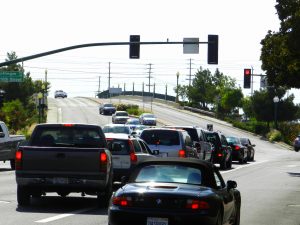
One of the promises of the proponents of Measure L is to synchronize traffic signals. While the cost to set the signals is minuscule compared to the revenue that would be raised by the measure, failure to synchronize the signals now is the height of government irresponsibility. The cost is so low and the benefit so great that before any roadwork is done, signals should be in sync.
When traffic signals are properly set, people save time. Smooth flowing traffic enables faster cross-town travel with minimal congestion, less aggravation, and less cost. As time is money for most people, why wouldn’t Modesto’s signals be synchronized? Synchronized signals reduce driving costs. Cars burn less gas when they don’t have to constantly stop and go. Smooth traffic flow optimizes gas mileage and saves taxpayers much more money than the cost to synchronize.
Synchronized traffic signals also reduce air pollution. Auto mechanics will confirm that a car traveling at a steady speed generates much less air pollution than cars forced to idle at traffic lights or travel in stop and go traffic. Considering that the San Joaquin Valley is a non-attainment area for national standards of air quality, the failure to synchronize signals constitutes gross negligence on the part of local government. In not helping to keep air as clean as possible, local government is partially responsible for the adverse health effects of excessive air pollution that chronically occupies the Great Valley. Regardless of whether Measure L passes, common decency and responsible government require that signals be synchronized now.
Synchronized Signals In Modesto
In 1999, when I became a Modesto City Council Member, I asked traffic director Firoz Vohra whether the city’s signals were synchronized. He said that he had wanted to set the signals ever since he was hired, but that no city council member had ever shown interest. When I left office in 2003, all the signals had been synchronized. A driver could travel up McHenry Avenue from downtown to the north edge of town without missing a single traffic light, except maybe during rush hour. Today, driving around town is once again exasperating. Signals need to be recalibrated periodically to keep them in sync. Given the benefits, one would expect recalibration to be a high priority, especially since the expense is relatively low.
Why is Synchronization Mentioned by Measure L Proponents?
Since Measure L’s plan includes signal synchronization, we must assume that elected leaders and local governments are aware of the benefits to the public. Does that suggest duplicity? Are elected leaders depriving citizens of smooth traffic flow to extort a “yes” vote? What sane reasoning is there to account for the lack of synchronized signals county-wide? Absent government that operates responsibly, voting for the Measure L tax increase is illogical.
